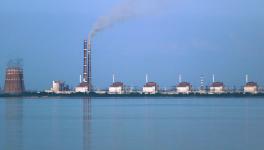People’s Commission Calls for National Fertiliser Policy to Reduce Imports, Strengthen CPSEs
Representational use only. Image Courtesy: Wikimedia Commons
New Delhi: Amid concerns over global availability and growing demand for fertilisers, as well India’s dependence on urea import, the People's Commission on Public Sector and Public Services (PCPSPS) has called for a national fertiliser policy, consistent with the long-term food security strategy in India.
“The national fertiliser policy should recognize the strategic nature of the domestic fertilizer industry and the urgent need to build up self-reliance by nurturing the fertilizer CPSEs, rather than dismantling them through disinvestment and privatisation,” said a statement issued by PCPSPS, which includes eminent citizens, such as former Kerala finance minister Thomas Isaac, former bureaucrat EAS Sarma, Senior advocate Indira Jaising, economist Prabhat Patnaik among others.
The statement comes in the backdrop of reports of long queues by farmers to buy urea and DAP for their Rabi crops in some states, such as Uttar Pradesh, Madhya Pradesh, Bihar etc., even leading to protests and angry incidents.
Read the full statement below:
The global fertilizer production situation and demand for fertilizers in the context of the rise in energy and gas prices, Covid 19 pandemic, and the ongoing Ukraine war are in urgent need of a critical evaluation of the policies and programmes under implementation for fertilizer production and use from the side of the policymakers, farmers’ leaders and scientists in India.
The demand for fertilizers has witnessed significant year-to-year growth over the past several years on account of which the import of fertilizer products and inputs that are not domestically available has also increased substantially. Globally, India is the second- largest fertilizer-consuming country, the third-largest producer and the largest importer of fertilizer materials. In the last 30 years, consumption of fertilizer materials was growing at a CAGR of 3.3 % whereas production grew only by 2.18 % necessitating huge imports which grew at an astonishing 5.81 % during the same period. In the last decade since 2011-’12 production of chemical fertilizer grew at the rate of 1.13% CAGR.
It is ironic that, though India has become self-reliant in food grain production and the planners have accorded a high priority to maintaining food security, it has simultaneously become heavily dependent on imports in the case of chemical fertilisers, which are input for food grain production. This is a result of the absence of a clear strategy to maintain self-sufficiency in fertilisers and on account of the lack of focus on the enhancement of fertilizer use efficiency in the co- evolving policy for food production.
Increasing fertilizer import dependence
The Peoples’ Commission on Public Sector and Public Services (PC) notes that following the retention pricing policy (RPS) and the encouragement given to public and private companies in the 1980s and up to 1995 the country attained self- sufficiency in urea production in the year 2000. During this period fertilizer production was mostly a public sector manufacturing activity. The sector slowly drifted towards the private sector following a lack of expansion of public sector units and also due to the closure of some of the operating units. In the wake of the liberalized economic policies, it was decided that no major government investment is needed in the public sector. Due to this change in government policy, there have been no major new investments since 1995 in the fertilizer sector also. Consequently, imports increased by leaps and bounds. In 2002 several plants which operated on coal, naphtha, fuel oil, and lignite were closed down on account of high specific energy consumption and increased cost of production. This also reduced domestic availability leading to higher imports.
Efforts by the government to encourage fertilizer companies to put up manufacturing facilities abroad where raw material is cheap and bring it to India to reduce fertilizer imports have also faded off. Attempts to procure and develop potash mines abroad have also not borne fruit. During the last two decades, there were several tinkerings with the fertilizer policy, but none of them were able to infuse new investments in the sector or reduce the subsidy burden on the government. Some of the major private players in the fertilizer business chose to exit the industry due to inordinate delay in the disbursement of subsidy amounts hitting them hard on working capital requirements. With the partial decontrol of pricing and introduction of nutrient-based pricing in 2008 the farm gate price of phosphatic and potassic fertilizers went up sharply severely straining the farmers.
Decreasing fertilizer use efficiency
The country is also faced with the challenge of finding a balance between the need to increase the amount of food and the negative socio-environmental and economic consequences of the irrational use of fertilizers. The Indian government’s efforts to attain better nutrient use efficiency of applied fertilizers in the field based on nationwide soil testing and balanced administration of fertilizers have not been able to gather momentum. The promotion of large-scale use of compost and farmland manure, biofertilizers, fortified fertilizers, and micronutrients did not get support as intended by the agricultural science community. There is no serious effort for the revival of legume-based crop rotations, recycling and reuse of nutrient-rich wastes for agriculture/horticulture, and use of nutrients recovered from sewage treatment using available technologies.
Urban composting on a large scale could have addressed the twin problems of managing the formidable challenge of urban waste generation and substituting to some extent the use of chemical fertilisers in agriculture. In fact, the Solid Waste Waste Management Rules of 2016 mandated different Central Ministries to market a balanced mix of urban compost and chemical fertilisers but the lack of a coherent strategy, including a few countervailing decisions taken by the government, hindered implementation of the Rules, thwarting attempts to address the compounding problem of urban waste handling and spiralling import of chemical fertilisers.
Continuing with the policy of privatization
Following economic liberalization, as a result of the government’s reluctance to make new investments in the public sector, the CPSE fertilizer production facilities have got neglected, resulting in many units being closed down for one reason or the other. In between some of the units like PPL were privatized. The planners remain blissfully indifferent to the challenge of growing import dependence. This is evident from the recent announcements (as recent as on May 28, 2022) coming from the Ministry of Finance on its resolve to disinvest National Fertilizers Ltd, Rashtriya Chemicals & Fertilizer Ltd, Madras Fertilizer, Fertilizer Corporation of India, Brahmaputra Valley Fertilizer Corporation and Hindustan Fertilizers Corporation, as also MMTC which imports fertilizers and raw materials. It shows that either the Ministry of Finance is in a total disconnect with the realities of global developments and the need to do everything necessary to safeguard food security or it has deliberately chosen to act against the national interest, in its undue exuberance to sell away the valuable CPSE assets to private companies.
It is somewhat ironic that private fertiliser companies should be earning excessive profits from their fertiliser business, largely as a result of the multiple sops given by the government, whereas the CPSE fertiliser companies, functioning in line with the welfare role of the State as envisaged in the Directive Principles of the Constitution, should be subject to government’s neglect, including the threat of privatisation. The Centre’s indiscriminate approach to privatisation of several fertiliser CPSEs, further compounded by its mindless privatisation of the State power DISCOMs, would, in the ultimate analysis, cripple the agrarian economy and adversely affect the lives of millions of small farmers across the length and the breadth of the country, especially at a time when their socio-economic condition stands disrupted by the successive waves of Covid pandemic.
The resultant situation has also brought trouble to the government. Ever since energy and gas prices become volatile in 2019-20 the domestic cost of production and imported prices have also gone up, and that is now resulting in a steep hike in the subsidy payout. While it was Rs 83,000 crore during 2019-20, which increased to Rs
1.38 lakh crore during 2020-21 and to Rs 1.62 lakh crore during 2021-22. In the current situation, it is expected to cross Rs 2.5 lakh crore during the current FY 2022- 23 which will certainly upset the fiscal balance of the Union government. It is clear that the sector has undergone all the strains associated with the neo-liberal policies. It is also clear that the government has not been able to transform the programs and policies related to the sector either for the achievement of self-reliance in fertilizer production or for the promotion of sustainable use and application of fertilizer at the farmers' end [1]. In India, small and marginal farmers are the worst affected. They constitute more than 80% of India’s agricultural sector, and paying high prices for fertilizers in the black market will hurt their incomes. Further, if they opt to not use fertilizers, crop yields will drop substantially and will drive food prices higher and worsen the already high inflation pushing 15 % of the poor into acute poverty and hunger.
The national system for ensuring sustainable fertilizer management needs the integration of the efforts of three basic actors: the government; the industry for developing, manufacturing, testing, and bringing fertilizers to the end-user (including research organizations, institutes, and universities); fertilizer users. Sustainable use and management of fertilizers is also the result of awareness of the problem, generation and accumulation of knowledge about possible ways to solve it, and development and implementation of specific tools at each decision-making level.
The roles of the Union government and the State government are critical to the success and consist in coordinating the economic interests of producers and society. The basic principles that should form the basis of the system of interactions of all the relevant actors in ensuring sustainable production and use of fertilizer: generation of knowledge of the diverse socio-ecological and economic impacts of fertilizer use practices, scientific and technological upgrading of the industry, the intermediaries and the farmers, professional decision-making, transparency, convergence of economic, environmental and social parameters of fertilizer application practices, information support and solution support at all levels, enhancement of trust between all and continuous system development at the national and state and district levels.
There are a few basic issues regarding the economics of farming vis-a-vis the use of fertilisers that the Commission wishes to flag here.
The majority of the cultivators in the country have small size holdings. The most optimal way to ensure their contribution to self-reliance in fertilizer and fertilizer use efficiency enhancement is to incentivise the farmers to pool their contiguous holdings together and form cooperatives, which will facilitate the implementation of a focused strategy to enhance their productivity and to bring about a reduction in the import bill.
In this context, an important problem with the records of rights of cultivators is that, in most States, the village revenue records do not often reflect the names of the small/ marginal farmers who cultivate the land. Though much has been made of computerisation, it has not brought about any change in this. A comprehensive set of land reform measures needs to be put in place to correct this situation, to recognise the occupation rights of small cultivators so that their title to land is established and they can access credit and other inputs without any hindrance.
As far as the increasing dependence on chemical fertilisers is concerned, indiscriminate application of chemical fertilisers, including their excessive use, driven by subsidies and over-aggressive marketing by fertiliser companies, has adversely affected the soil quality in many places and unduly increased the water intensity of the crops, which calls for a thorough review of the present approach to increasing agricultural production through the use of chemical fertilisers.
These are important concerns that the planners cannot afford to ignore and appropriate strategies are urgently called for.
We request the Union Government to take note of the global developments in the availability of fertilizers and the raw materials required for fertilizer production and quickly put in place a national fertilizer policy, consistent with the long-term food security strategy. The national fertiliser policy should recognize the strategic nature of the domestic fertilizer industry and the urgent need to build up self-reliance by nurturing the fertilizer CPSEs, rather than dismantling them through disinvestment and privatization. The following points need to be pro-actively considered by the Union government.
1. In the wake of the Ukraine war, the much-criticized administered pricing system (APS) for urea prevailing since 1978, has come up to save the farmers by insulating them from the current huge price rise and the industry getting reasonable returns. There is a vehement call for the decontrol of urea from several quartets. The Govt may disregard the same, lest it may have to politically pay a huge price on account of the added distress to the already overburdened farming community.
2. As regards the partial decontrol of phosphate and potassic fertilizers through nutrient-based pricing (NBS), the bulk of the price rise in imported and domestically manufactured fertilizers is borne by the farmers. Essentially, they have to be compensated through an increase in minimum support price union (MSP). Considering that farming as an activity faces greater risks compared to any industry and it is perhaps far more critical for national development on all fronts than the industrial sector, the Commission strongly feels that it is high time that the government adopts agricultural pricing based on the recommendations of the Swaminathan Committee and makes sure that the benefits of such revised pricing go to the small and marginal cultivators. The NBS pricing may be reviewed to ensure that manufacturers do not reap huge profits at the expense of the government and the farmers.
3. The government shall have a steadfast action plan to increase in domestic production of fertilizers through the green ammonia route. As ammonia, the major fertilizer input is slated to become a fuel of the future for long-distance hauling, its production will serve the twin purposes of production of fertilizers and as a reserve fuel.
4. Preferential allocation of natural gas to the fertilizer sector may be restored. Now the sector gets domestic gas after allocation to household consumption and for automobiles.
Even after intensified efforts, the privatization of CPSUs is not catching up to yield the quantum of proceeds intended in the past budgets. Now-a-days it appears that the whole process remains stalled.
1. In this situation, the Govt shall withdraw all activities towards the privatization of fertilizer PSUs, plan and undertake their systematic expansion and diversification.
2. More diligent use of available (indigenous and imported) urea and DAP is the need of the hour. The Govt has done certain efforts in the past years to achieve a balanced and scientific application of mineral nutrients in our farmlands. Here only partial success is achieved. A more concerted action plan for effective soil testing and fertilizer administration is warranted not only to conserve costly fertilizers, and reduce their waste but also to ward off their leaching and consequential environmental problems. Moreover, existing agricultural practices may also be reviewed by incorporating crop rotation by legumes etc, through a professional engagement with agricultural universities, scientists and crop-nutrition experts.
3. Low nutrient content fertilizers such as ammonium sulphate and mono ammonium phosphate may be promoted so that there is no excessive nutrient application and the plant absorbs almost all the nutrients supplied during the cropping season itself without any wastage.
4. Existing fertilizer plants may have the capability to produce beyond their nameplate capacities. Production beyond the assessed quantum was not encouraged earlier to avoid investors ‘gold plating’ to claim more capital subsidies under the administered pricing mechanism (APM). In the renewed situation all producers may be encouraged to produce whatever is possible to tide over the prevailing exorbitant import prices, especially in the wake of the Ukraine war.
5. Fast commission the urea plants under construction. Ramagundam fertilizers and HURL, Gorakhpur have started operations, HURL Baruni is expected by June this year, Talcher unit is set to become operative by end of 2024. Have a dedicated effort to fast-track the commissioning and operation of these projects. Necessary carbon capture and sequestration (CCS) facilities may be added to these newly built plants to align their operations with the country’s emission reduction targets.
6. Urban and City compost may be given a renewed thrust to meet part of our nutrient demand. Encourage more and more municipalities and corporations to mandatorily implement such projects. This will not only render cities and neighbourhoods clean but also provide low-analysis fertilizers for horticulture etc. The subsidy payment to composting units may be revived.
7. Try blending Urea and DAP with city composts so that better assimilation by the plant is rendered easy. Indirectly it will reduce the wastage of concentrated fertilizers.
8. Have a nationwide program to promote the use of agricultural wastes, green leaves and farmland manure as readily available sources of manure for crops.
9. Promote an effective utilization of low-grade rock phosphate deposits available in the country (Rajasthan etc) through advanced beneficiation etc.
10. Gypsum from salt pans contains several plant nutrients and is used as manure and also in cement plants. The use of this material as manure may be incentivized and instead cement plants may be directed to use phospho- gypsum or mined gypsum.
11. The Govt proposes to modify existing agricultural input retail shops into one- stop shops for all the needs of the farmers. The farmers will be able to purchase agricultural inputs like seeds, fertilizer, and agrochemicals will get information on government schemes and can avail the facility for soil testing, etc. from these shops. As all of the above items are essential inputs to agriculture and are demanded at specific periods of the year, if these shops are entrusted with the private players without the involvement of universities, research institutions and government departments in the decision-making at the local level of their operations as well as advisory services to the farmers it will breed large-scale inefficiency, black marketing as well as corruption and therefore these operations including advisory and testing services need to be managed either in the public or co-operative sector bodies under the supervision of public universities and government departments responsible for crop production and input use.
12. The ammonia industry in the country has amassed vast expertise in the design, execution, handling, storage, and safety of handling hydrogen. This strength may be used and the fertilizer sector may give a responsible role in National Hydrogen Mission in its developmental efforts.
[1] The components of China’s success in this area are: legislative regulation of the need for soil testing and development of recommendations for fertilization and Zero Increase Action Plan, which facilitates a 50% reduction in nitrogen and phosphorous use and 100% nutrient efficiency without reducing yields. In 2019, in China all provinces reported on the achieved zero level of increase in the amount of fertilizers and development and implementation of a package of flexible economic tools (depending on the socio-economic conditions of the region) that encourage producers to analyze soils, introduce recommendations for fertilizers, use organic substances to increase soil fertility; ensure the coordinated work of all components of the fertilizer management chain; support for scientific developments and their distribution.
Get the latest reports & analysis with people's perspective on Protests, movements & deep analytical videos, discussions of the current affairs in your Telegram app. Subscribe to NewsClick's Telegram channel & get Real-Time updates on stories, as they get published on our website.























